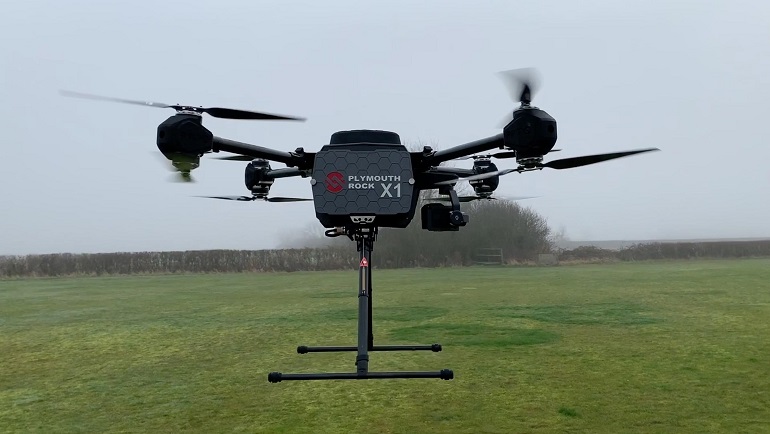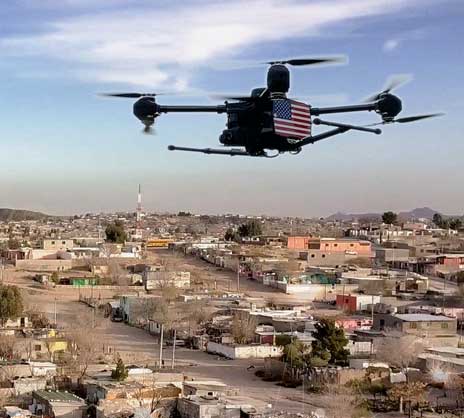You’ll be astonished by what
American-made drones can now do!

Some of the world’s most brilliant experts in designing drones to solve real-world issues are in Plymouth, Mass.
You may not see them except perhaps during sporting events, but commercial Unmanned Aircraft Systems (UAS), commonly known as drones, are dramatically improving many aspects of our daily lives. From locating skiers buried in avalanches to performing surveys, drones now have a massive number of potential uses.
But there’s also been a huge problem. Many commercial drones are made with Chinese technology and are now considered national security risks because the Chinese have access to the information feeds. Even though many U.S. governmental groups have grounded all their Chinese drones, the market is still flooded with Chinese drones that have intelligent recording and reporting capabilities being used by industrial surveyors.
An American Success Story
U.S.-based Plymouth Rock Technologies (PRT) is a company committed to advancing unmanned technology using US-made or NATO partner-sourced parts. PRT is an ISO 9001 quality assured business that builds unmanned systems that comply with the National Defense Authorization Act (NDAA).
PRT’s drones are being selected by U.S. and U.K. government agencies, law enforcement and the military, not simply because of their compliance and accreditation of quality assurance but also because they can fly with more sensors, over much longer distances with longer flight times, carrying significantly more payloads than their competition.
What truly defines their offering are their all-weather capabilities and their primary inbuilt design capability to be flown beyond the operator’s visual line of sight (BVLOS).
The PRT BVLOS capability has been field tested more than any other manufacturer in operational missions, deriving from several hundred flights with the United Nations and similarly with Aardvark services. Aardvark operates a PRT X1 hybrid that is used to monitor the assets of Shell Oil and Chevron in remote locations in Kazakhstan.
The team at PRT is also leading technological advancements by leveraging the use of artificial intelligence, collision avoidance systems, and systems for communicating with air traffic control and airport towers. This was officially recognized for their selection by the U.K. CAA for the Unmanned / Manned test corridor to demonstrate the ability of unmanned systems to intelligently sense and avoid commercial air traffic and other unmanned aerial systems.

PRT drones can do THAT?
“PRT currently has five drone models, each of which can be customized for specific applications,” says CEO Dana Wheeler. Their uses include:
Infrastructure inspections. From oil and gas pipelines to wind turbines, PRT’s agile drones can quickly and easily access places that may be inaccessible by most other means. They can also be used to survey extensive distances for road and bridge damage.
Swift responses to medical emergencies. PRT drones can be used to deliver blood, vaccinations and even defibrillators to hard-to-reach areas during medical emergencies. This applies to more than just freeways blocked due to accidents. They are also lifesaving situations in military scenarios where using crewed helicopters or vehicles would be too risky.
Agricultural assessments. PRT’s drones can be used to determine if there are some plants not getting enough irrigation or can scoop up soil samples for testing; and have been used to re-seed acreage during U.N. missions.
Wildlife conservation. PRT is currently running trials using drone-based thermal infrared cameras to monitor endangered rainforest species and identify any potential poachers. In a single 20-minute flight, a PRT drone can cover a greater area of marsh than a canoe team can cover in two days, which can hugely increase the efficiency of conservation surveys.
Search and rescue. It can be difficult for helicopters to land in heavy foliage but PRT drones can extract an injured hiker or lost child from a remote location. PRT drones can also use infrared and millimeter sensors to find people buried in snow, pinpointing their location within a two- or three-foot area.
Law enforcement. A typical police helicopter can stay in the air for 70 minutes. PRT’s drones can be in the air for up to six hours, travel at a similar speed to a helicopter, safely undertake high-speed pursuits and have the ability to use thermal technologies to track potential suspects or find a missing person.
Saving the lives of our military personnel. PRT’s XMR heavy-lift multirotor UAS has been designed for medical evacuation and resupply. The super heavy lift platform has a 150kg payload capacity, making it capable of extracting an injured soldier from the battlefield or carrying out vital resupply of delivery roles across a range of applications.
To learn more about Plymouth Rock Technologies and its team’s accomplishments, visit www.plyrotech.com
Biography:

Dana Wheeler, Director, President and CEO
Dana Wheeler is a recognized industry veteran with more than 35 years’ experience in radio frequency, microwave and millimeter-wave technologies. He has a proven track record of successful start-ups, mergers and acquisitions.
In the past, he has held positions with M/A-Com, Millitech, Lockheed Martin, Harmonix Corp (HXI), Terabeam and Proxim.
He is the founder of Radio Physics Inc.
Wheeler is a graduate of the University of Massachusetts, Dartmouth.
